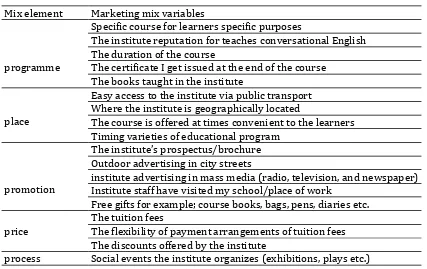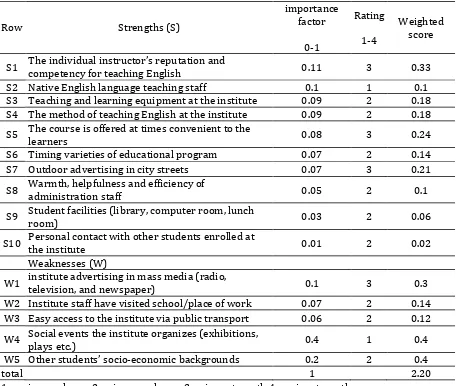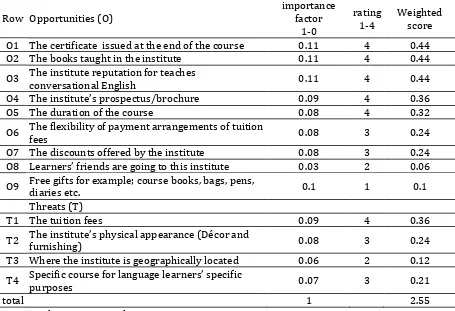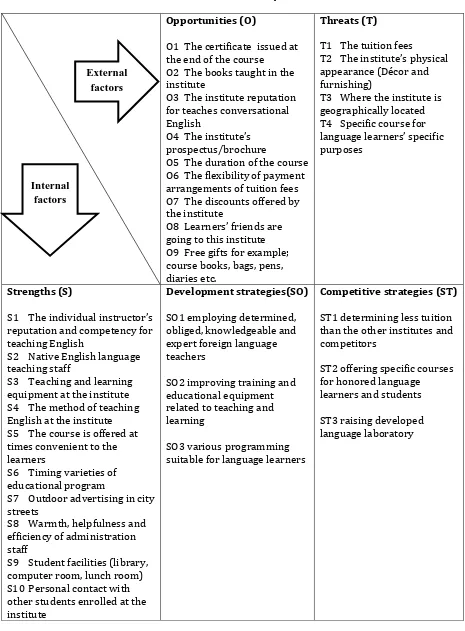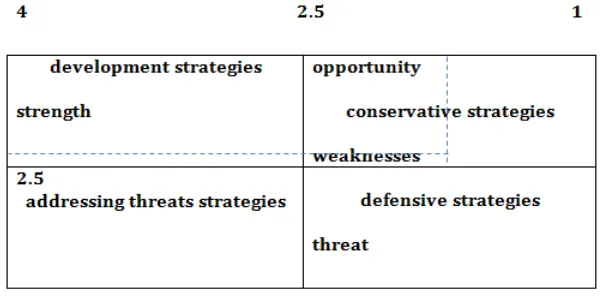Journal of Applied Linguistics and Language Research Volume 4, Issue 2, 2017, pp. 139-149
Available online at www.jallr.com ISSN: 2376-760X
* Correspondence: Farzane Safarzade Samani, Email: f_samani8737 yahoo.com © 2017 Journal of Applied Linguistics and Language Research
Strengths, Weaknesses, Opportunities and Threats (SWOT)
Analysis
and Strategic Planning for Iranian Language
Institutions Development
Seyyed Morteza Hashemi M.A in TEFL, Chabahar Maritime University, Iran
Farzane Safarzade Samani * M.A in TEFL, Chabahar Maritime University, Iran
Vahide Shahbazi
M.A in Management, Chabahar Maritime University, Iran
Abstract
As the competition among language institutions in Iran increases, the need for applying a strategic framework to know institution strengths and weaknesses and make use of opportunities to remove treats sounds necessary. The purpose of the current study is to plan strategies for language institutions using SWOT analysis to establish a unique difference and to give the learners a reason to choose that institution. A questionnaire was developed based on Kotler and Fox's (1995) marketing mix elements (7Ps). The participants were four experienced language institution teachers in Chabahar, Iran, aged between 25 and 35. Based on the results, the instructor’s competency; social events the institute organizes; the books taught in the institute and the tuition fees were among the most important strengths, weaknesses, opportunities and threats, respectively. The most top identified strategies that must be considered, according to importance factor, were ‘employing knowledgeable foreign language teachers; determining less tuition than the other institutes; increasing institute publicity by advertising in mass media and distributing brochures; offering special language courses suitable for specific goals of language learners’.
Keywords: SWOT analysis, language institution, marketing mix element, strategic planning
INTRODUCTION
into considerations by learners when choosing a language institution. Some learners could be persuaded by promising claims made by marketing propaganda such as advertisements and brand name. On the other side, many people have some experience in English teaching at various levels, however, not everyone has the skills to open, organize and run an institution successfully. In order to survive and to achieve a sustainable competitive advantage, educational institute needed to maintain or develop a distinct image to create competitive advantage in an increasingly competitive market (Hoyt & Brown, 2003). Applying a marketing framework that enables institutions gain insights into the past and think of possible solutions for existing or potential problems is vital. Strategic planning is one of those practical frameworks which help mangers adapt products, services or activities to the needs of the population their program serves. The benefits of strategic planning include improved program performance, use of resources, understanding of program context, decision making, stakeholder communication, and political support for the program (Bryson, 2004). SWOT analysis (Strengths, Weaknesses, Opportunities and Threats) is one of several strategic planning tools which that takes the information from an environmental analysis and separates it into internal (strengths and weaknesses) and external issues (opportunities and threats) (Ifediora, Idoko, & Nzekwe , 2014). Specifically, SWOT is a basic and candid model that assesses what a language institution can and cannot do, as well as its potential opportunities and threats (Ommani, 2011).
The current study seeks to plan strategies for language institutions by means of SWOT analysis to establish a unique difference which highlights their strength and givens the learners a reason to choose that institution. The questionnaire have been provided based on mix marketing elements that is a set of controllable tools and techniques (elements) available for an institution to shape the nature of its offer to learners. It is to put the educational service offering into a number of component parts and arrange them into manageable subject areas for making strategic decisions (Palmer, 2001). LITERATURE REVIEW
A strategic plan, as mentioned before, is a program planning tool that provides a blueprint to strengthen program activities, improve weaknesses, and move the program forward to new accomplishments. The emergence of strategic planning in higher education coincided with the difficulties experienced in education in the 1970s and 1980s, when enrollments began to fluctuate, student demographics started to change, and funding became inconsistent. At this point, future research pointed the way to strategic planning as one solution for developing a proactive stance in the environment of changing demands and declining resources (Hinton, 2012)
threats involved in any business enterprise, including language institutions business (Hinton, 2012). Summarized SWOT analysis matrix has been shown in table 1.
Table 1. SWOT analysis matrix (Whalley , 2010)
Strengths Weaknesses
Opportunities How do I use these strengths to take advantage of these opportunities?
How do I overcome the weaknesses that prevent me from taking advantage
of these opportunities? Threats How do I use my strengths to reduce
the impact of threats?
How do I address the weaknesses that will make these threats a reality?
In one hand, SWOT analysis, aims to assess the environmental opportunities and threats and in the other hand, to evaluate the internal strengths and weaknesses of a system. SWOT model gives a systematic analysis for the recognition of these factors and also for the choice of a strategy that establish the best symmetry among them. In terms of this model, a suitable strategy which maximizes the strengths and opportunities and minimizes the weaknesses and threats supposed to be provided. For this reason, the aforementioned strengths, weaknesses, opportunities and threats are connected in four general states (SO, WO, ST, WT) and in consequence, the strategic options are selected from the combination and composition of these factors (table. 2).
Table 2. SWOT matrix and strategy determination process SWOT matrix Strengths(S) Weaknesses(W) Opportunities(O) SO strategies WO strategies
Threats(T) ST strategies WT strategies
A brief explanation about four factors (Strengths, Weaknesses, Opportunities and Threats) is given below (Ifediora et al., 2014):
Strengths are the qualities that enable managers to accomplish the institution’s mission. Strengths are attributes or characteristics within the organization that are considered to be important to the execution and ultimate success of the institution. Strengths can be either tangible or intangible, include experienced management, assets (physical, human, intangible), competitive capability etc.
Weaknesses have to do with internal factors that could prevent the achievement of a successful result to the institution. These weaknesses deteriorate influences on the organizational success and growth. Weaknesses are the factors which do not meet the standards supposed to be met. Weaknesses are controllable and must be minimized and eliminated. Weaknesses in an institution may be insufficient facilities, lack of staff and teachers skills, etc.
opportunities and grasp them whenever they arise. Opportunities can come in the form of the best prospects, competitive advantage and good match with what we have to offer.
Threats arise when conditions in external environment jeopardize the reliability and profitability of the institution. They compound the vulnerability when they relate to the weaknesses. Threats are uncontrollable. When a threat comes, the stability and survival can be at stake. Among the possible threats that will be critical to any analysis is a negative public image, ever changing technology, competitive behavior, etc.
Related studies
SWOT matrix is one of the efficient qualitative models that have been widely used for various purposes. For example it was used for assessment of rural tourism in Turkey as Turkey has an important rural tourism potential (Akca, 2006 as cited in Ommani, 2011). Singh (2010) conducted SWOT analysis in identifying strategies for community development. He identified and prioritized some categories for the development of villages in future e.g., conservation and utilization of natural resources, promotion of health, etc. Ommani (2011) used this analysis for farming system businesses management in rural areas of Iran and some strategies were prioritized (e.g. development of poor local market opportunities and infrastructure, planting of crops with high economic values).
METHODOLOGY
Method and Design
This research is a quantitative and applied one and it is a descriptive-survey in terms of research type. As in a descriptive study the data is based on primary and original data for example a questionnaire (Brown, 1995). This study is a survey study which typically focuses on a group of teachers’ attitudes, opinions and characteristics. The researcher collected and analyzed data quantitatively.
Participants
The participants of this study were four experts, two male and two female, who had enough experience in teaching English in language institutions in Chabahar, Iran, aged between 25 and 35. These teachers were supposed to be representative of the accessible population since they had enough experience.
Instruments
Questionnaire
For collecting needed information on teachers’ opinions, a questionnaire was used. The questionnaire was developed based on Kotler and Fox's (1995) marketing mix elements (7Ps). For each of these 7Ps (programme, place, promotion, price, process, physical facilities and people) some subcomponents or variables have been defined. Table 3 shows 28 marketing subcomponents on which the questionnaire was drafted. The participants were asked to divide these variables into the external and internal factors and then evaluate and rank each item.
Table 3. Marketing mix variables (Kotler and Fox,1995) Mix element Marketing mix variables
programme
Specific course for learners specific purposes
The institute reputation for teaches conversational English The duration of the course
The certificate I get issued at the end of the course The books taught in the institute
place
Easy access to the institute via public transport Where the institute is geographically located
The course is offered at times convenient to the learners Timing varieties of educational program
promotion
The institute’s prospectus/brochure Outdoor advertising in city streets
institute advertising in mass media (radio, television, and newspaper) Institute staff have visited my school/place of work
Free gifts for example; course books, bags, pens, diaries etc.
price
The tuition fees
The flexibility of payment arrangements of tuition fees The discounts offered by the institute
The method of teaching English at the institute
Physical facilities
Teaching and learning equipment at the institute. Student facilities (library, computer room, lunch room) The institute’s physical appearance (Décor and furnishing)
people
Personal contact with other students enrolled at the institute Native English language teaching staff
Warmth, helpfulness and efficiency of administration staff The individual instructor’s reputation for teaching English Other students’ socio-economic backgrounds
Learners’ friends are going to this institute
Procedure
In the first phase of the research, experienced experts divided external and internal factors external into (opportunities and threats) and internal (strengths and weaknesses) factors based on Kotler and Fox's 7Ps element. These factors were defined to affect learners’ choice and language institutes issues. In the second phase, based on the teachers’ idea, each item was evaluated and ranked and the importance ratio coefficient from 0 to 1 was identified. For analyzing external factors one requires looking outside the language institution at issues that cannot be controlled but can manage to enhance or reduce their impact on the institution. External factor evaluation (EFE) matrix is a strategic-management tool used to visualize and prioritize the opportunities and threats that a business is facing. Internal factor evaluation (IFE) matrix is a strategic management tool used for evaluating strengths and weaknesses in functional areas of a business. The IFE matrix together with the EFE matrix as a strategy formulation tools is utilized to evaluate the performance of the institution with regards to the identified internal strengths and weaknesses of an institution.
Data analysis
The data of the current study was analyzed by the SWOT matrix. According to Whalley (2010), to make use of SWOT analysis technique which is the first step of planning, four strategic groups should be considered: (1) how strengths are used to take advantage of opportunities? How weaknesses are reduced by taking advantage of opportunities? (3 How strengths are used to reduce the impact of threats? (4) How weaknesses that will make these threats a reality are addressed?
RESULTS AND DISSCUSIION
Table 3. Internal factors evaluation (IFE) matrix.
Row Strengths (S)
importance factor
0-1
Rating
1-4
Weighted score
S1 The individual instructor’s reputation and competency for teaching English 0.11 3 0.33
S2 Native English language teaching staff 0.1 1 0.1 S3 Teaching and learning equipment at the institute 0.09 2 0.18 S4 The method of teaching English at the institute 0.09 2 0.18
S5 The course is offered at times convenient to the
learners 0.08 3 0.24
S6 Timing varieties of educational program 0.07 2 0.14 S7 Outdoor advertising in city streets 0.07 3 0.21
S8 Warmth, helpfulness and efficiency of
administration staff 0.05 2 0.1
S9 Student facilities (library, computer room, lunch
room) 0.03 2 0.06
S10 Personal contact with other students enrolled at
the institute 0.01 2 0.02
Weaknesses (W)
W1 institute advertising in mass media (radio,
television, and newspaper) 0.1 3 0.3
W2 Institute staff have visited school/place of work 0.07 2 0.14 W3 Easy access to the institute via public transport 0.06 2 0.12
W4 Social events the institute organizes (exhibitions, plays etc.) 0.4 1 0.4
W5 Other students’ socio-economic backgrounds 0.2 2 0.4
total 1 2.20
1=major weakness 2=minor weakness 3=minor strength 4=major strength
Table 4. External factors evaluation (EFE) matrix
Row Opportunities (O)
importance factor
1-0
rating 1-4
Weighted score
O1 The certificate issued at the end of the course 0.11 4 0.44 O2 The books taught in the institute 0.11 4 0.44
O3 The institute reputation for teaches conversational English 0.11 4 0.44
O4 The institute’s prospectus/brochure 0.09 4 0.36
O5 The duration of the course 0.08 4 0.32
O6 The flexibility of payment arrangements of tuition fees 0.08 3 0.24
O7 The discounts offered by the institute 0.08 3 0.24 O8 Learners’ friends are going to this institute 0.03 2 0.06
O9 Free gifts for example; course books, bags, pens,
diaries etc. 0.1 1 0.1
Threats (T)
T1 The tuition fees 0.09 4 0.36
T2 The institute’s physical appearance (Décor and
furnishing) 0.08 3 0.24
T3 Where the institute is geographically located 0.06 2 0.12
T4 Specific course for language learners’ specific purposes 0.07 3 0.21
total 1 2.55
1=major threat 2=minor threat 3=minor opportunity 4=major opportunity
Table 5. SWOT analysis Opportunities (O)
O1 The certificate issued at the end of the course
O2 The books taught in the institute
O3 The institute reputation for teaches conversational English
O4 The institute’s prospectus/brochure
O5 The duration of the course O6 The flexibility of payment arrangements of tuition fees O7 The discounts offered by the institute
O8 Learners’ friends are going to this institute O9 Free gifts for example; course books, bags, pens, diaries etc.
Threats (T)
T1 The tuition fees
T2 The institute’s physical appearance (Décor and furnishing)
T3 Where the institute is geographically located T4 Specific course for language learners’ specific purposes
Strengths (S)
S1 The individual instructor’s reputation and competency for teaching English
S2 Native English language teaching staff
S3 Teaching and learning equipment at the institute S4 The method of teaching English at the institute S5 The course is offered at times convenient to the learners
S6 Timing varieties of educational program
S7 Outdoor advertising in city streets
S8 Warmth, helpfulness and efficiency of administration staff
S9 Student facilities (library, computer room, lunch room) S10 Personal contact with other students enrolled at the institute
Development strategies(SO)
SO1 employing determined, obliged, knowledgeable and expert foreign language teachers
SO2 improving training and educational equipment related to teaching and learning
SO3 various programming suitable for language learners
Competitive strategies (ST)
ST1 determining less tuition than the other institutes and competitors
ST2 offering specific courses for honored language learners and students
ST3 raising developed language laboratory
Internal factors
The strategic position and action evaluation (SPACE) matrix is a management tool for analyzing an organization’s business. It is used to determine what type of strategy a business should undertake. As it is illustrated in figure 1, the SPACE matrix is broken down into four quadrants, where each quadrant suggests a different type of strategy: development, conservative, defensive and competitive. The SPACE matrix analysis functions upon two internal and two external strategic dimensions. Based on the results, the score of the external and internal factors was 2.55 and 2.20, respectively.
Figure 1. Strategic position and action evaluation (SPACE) matrix CONCLUSION
As the competition among language institutions in our country increases, the need for applying a strategic framework that enables these institutions know their strengths and weaknesses insights and make use of opportunities and remove treats sounds vital. The Weaknesses (W)
W1 Institute advertising in mass media (radio, television, and newspaper)
W2 Institute staff have visited school/place of work W3 Easy access to the institute via public transport W4 Social events the institute organizes (exhibitions, plays etc.) W5 Other students’ socio-economic backgrounds
Conservative strategies (WO)
WO1 increasing institute publicity by mass media and brochure distribution
WO2 sending representatives from institute to publicize the capabilities of the institute and to answer the questions of interested people
WO3 offering discount on the costs of institute
WO4 employing English native speaking teachers WO5 offering distance-learning courses with the possibility of interaction among learners and teachers and learners themselves WO6 employing experienced and efficient personnel
Defensive strategies(WT)
WT1 reviewing the exams and language learners admission procedures
WT2 offering special
language courses suitable for specific goals of language learners
current study by means of SWOT analysis tried to help the planners to identify the strategies of achieving goals. Based on the results of this study, the identified strategies play a vital role in language institution system development. The important strategies that must be considered, according to importance factor given by the teachers were employing determined, obliged, knowledgeable foreign language teachers; determining less tuition than the other institutes and competitors; increasing institute publicity by advertising in mass media and distributing brochures; offering special language courses suitable for specific goals of language learners and etc. For stability in an institution, principals should take objectives into consideration, what were their success areas, failures, what was their major strength and weakness and how they handled them, what opportunities they had in the past and how they utilized it and finally the threat and how they handled it. The results of the study ensure researchers and planners that SWOT analysis plays a vital role in organization stability.
REFERENCES
Brown, J. D. (1995). Understanding Research in Second Language Learning. New York: Cambridge Univercity Press.
Bryson, J. M. (2004). Strategic planning for public and nonprofit organizations : a guide to strengthening and sustaining organizational achievement (3rd ed.). San Francisco: Jossey-Bass.
Harrison, J. (2010). Strategic Planning and SWOT Analysis. In J. Harrison, Essentials of Strategic Planning in Healthcare (pp. 91-97). Health Administration Press. Available on line on https://www.ache.org/pdf/secure/gifts/Harrison_ Chapter5.pdf
Hinton, K. (2012). A Practical Guide to Strategic Planning in Higher Education. Society for College and University Planning (SCUP).
Hoyt, J. E., & Brown, A. B. (2003). Identifying college choice factors to sucessfully market your institution. College and University.
Ifediora, C., Idoko, O., & Nzekwe , J. (2014). Organization’s stability and productivity: the role of SWOT analysis an acronym for strength, weakness, opportunities and threat. International Journal of Innovative and Applied Research, 2(9), 23- 32.
Khamova, S. (2013). Weaknesses in the Process of English Language Teaching. International Journal of Humanities and Social Science, 3(20), 33-36.
Kotler, P., & Fox, K. (1995). Strategic Marketing for Educational Institutions. Englewood Cliffs, N.J.: Prentice-Hall.
Ommani, A. (2011). Strengths, weaknesses, opportunities and threats analysis for farming system businessesmanagement: Case of wheat farmers of ShadervanDistrict, Shoushtar Township, Iran. African Journal of Business Management, 9448-9454.
Palmer, A. (2001). Principles of Services Marketing (3rd Ed.). London: McGraw-Hill. Razmjoo, S., & Nouhi, N. (2014). A SWOT Analysis of the Junior High School English
program: Grounded Theory Approach. International Journal of Language Learning and Applied Linguistics World, 5(1), 306-312.
